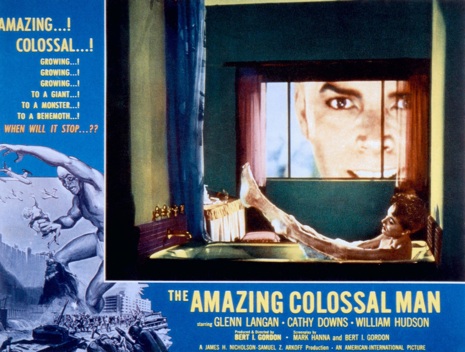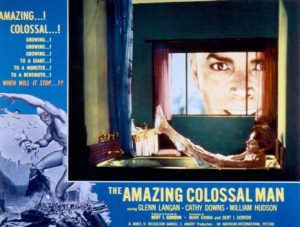I saw something of my own childhood, albeit at a decade’s remove, in Colson Whitehead’s memoir of growing up in the seventies with low-budget, low-esteem science-fiction movies. He writes, “If I was lucky, I’d come home from elementary school to find WABC’s ‘The 4:30 Movie’ in the middle of Monster Week,” and that was my experience, too. Among my very earliest cinematic memories, from the mid-sixties, are movies revealed on that broadcast, though the films he cites, “Frogs” and “The Power,” from 1972 and 1968, respectively, came too late for me. Even the very title “Monster Week” was, as I recall, a latter-day product of a more self-consciously joshing way with the medium. I remember a solemn on-screen science-fiction rubric, and the difference of a decade, of a mood, and of the relevant films was crucial: science fiction connects to science, and the B-movies that were broadcast, and that obsessed me between the ages of about five and eight, came from the fifties and early sixties and were tethered to the promise and the peril of new technologies.
As a kid in the age of Sputnik, those technologies were my underlying obsession, as they were the nation’s. From the atomic bomb (which, as I had learned, ended the war and thus possibly saved my father’s life, as he was about to be redeployed to the Pacific theatre) to the polio vaccine to the race to the moon (on which a family friend, an engineer, was working) to a panoply of pleasures and comforts (such as television and air-conditioning), science enjoyed a gleaming reputation in our home, and I enjoyed science in school and, of course, expected to become a scientist, whatever that meant. But thanks to the Museum of Natural History, dinosaurs crept into the equation—paleontology became, for me, a primordial ontology, and the very notion of the inaccessible past fused with a vision of a quasi-utopian future (that may be why the dinosaur scene in “The Tree of Life” struck me as perfect: I assume that, in his childhood, Terrence Malick had read the same pop-science books, with the same illustrations, that I had read) to forge the connection between investigation and imagination, or, more bluntly, between fact and fiction.
What they showed those afternoons on Channel 7—thin yet hectic fantasies, such as “Earth vs. the Spider,” “Earth vs. the Flying Saucers,” “Beginning of the End,” and “The Brain That Wouldn’t Die”—fed a fascination with science while also catering to a child’s apocalyptic imagination as well as addressing a child’s fears. There was nothing ironic or self-mocking about these movies; they had some of the grandiose adult earnestness of science, but they replaced its careful, incremental, workaday progress with visions emerging from its most spectacular achievements. In the same way that imagining diseases (and, in imagination, immediately unleashing their deadly force upon an unsuspecting world) was, for a child, more enticing than pondering cures for real ones, watching the furious force of monsters from deep within or from distant galaxies was a way of confronting the most monstrous possibilities that loomed just outside one’s own secure life, or, for that matter, those monstrous feelings that a child feels, moment to moment, in the face of every constraint, whether practical or moral.
My very favorite of them was a diptych: “The Amazing Colossal Man” and its sequel, “War of the Colossal Beast.” Glenn Manning (played by Glen Langan), a soldier in a trench at the perimeter of the site of an impending atom-bomb test becomes a hero when, during the countdown to the blast, a pilot crashes a small plane nearby. Dashing out of his trench to try to save the pilot, Glenn is gravely burned in a shower of nuclear debris, but, somehow, survives. Not only does his skin suddenly heal, but he begins to grow, and keeps growing, turning into an angry freak, demented (the “science” being that his brain doesn’t keep up with the rest of his growth) and dangerous. In the sequel, he survives a calamitous fall at the Hoover Dam after a military assault, and comes back more monstrous and madder than ever (“Glenn! Put the bus down!”).
Every child is a giant at the center of his own world, and the image of the outsized self in action—an embarrassment as well as a danger, a bigger center of attention than one ever wanted to be and a bigger pain than one ever intended to be—had a strangely cathartic impact, even as it captured the hysterical incongruities in alluring images of flamboyant imagination. The director Bert I. Gordon (who seems to have been my primordial auteur) didn’t do much in the way of character development or psychological subtlety, but he sure knew how to make a visual metaphor—to convey extravagant emotions, indeed, the mental overdrive of youth itself, in simple images. Monster movies are movies of self-transformation; even a child knows that makeup goes into the creation of the roles—and also knows that, as Socrates said, from the imitation one draws off some of the being. From my afternoon Bs, I picked up—and have never shaken—the idea of movies as something other than a representation of characters or a study of behavior. They mattered to me (as they still do) as reimaginations of the self, detached collections of visual extravagances that capture something of existence as a whole, as works of amazing and colossal ambition and scope.
This primal pleasure in the potent image also conditioned me to a cinematic hedonism that, to this day, is the motivating force in watching and discussing movies. Pleasure in the images (and, in another post, I’ll try to discuss the nature of this pleasure) is the first and the main reason to watch movies. It’s the gateway to empathy with a director’s point of view, and it fuels the deployment of analytical tools; in the absence of such pleasure, I hope that the word “interesting” is heard as a tacit term of contempt.
I sat down to write this post with an invigorating enjoyment in reimagining some of the formative outer and inner experiences of early childhood and avowing, to myself and to others, an unshaken fidelity to them. Yet midway through, ruefulness took over as the retracing of some decisive early steps—ones taken with an exuberant blindness to their import—turned into a sidelong glance at a whole landscape full of roads not taken and of missteps along the way. If my hive of Bs taught me anything, it’s that every possibility is also a limitation, every dream a potential nightmare, every invention a labyrinthine trap, and there’s no going back. One heads further into the vortex, accompanied by ever wilder images in an ever more fervent confrontation with—and acceptance of—the definitively unrepresentable void.
Read more http://www.newyorker.com/online/blogs/movies/2012/05/b-movies-childhood.html#ixzz1wSUGUKze


